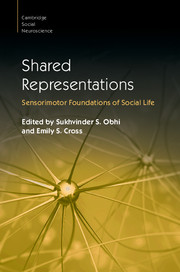Book contents
- Shared Representations
- Cambridge Social Neuroscience
- Shared Representations
- Copyright page
- Contents
- Figures
- Tables
- Boxes
- Contributors
- Preface
- Part I Foundations
- 1 What It Takes to Share a Task
- 2 Merged Minds
- 3 A New View of the Motor Cortex and Its Relation to Social Behavior
- 4 Beyond Action
- 5 Cognizance of the Neuroimaging Methods for Studying the Social Brain
- Part II Imitation and Mimicry
- Part III Thinking, Perceiving and Acting with Others
- Part IV Understanding Others
- Part V Learning and Development
- Part VI Shared Representations in Applied Contexts
- Index
- Plate Section (PDF Only)
- References
4 - Beyond Action
Shared Representations in Non-Motor Domains
from Part I - Foundations
Published online by Cambridge University Press: 27 October 2016
- Shared Representations
- Cambridge Social Neuroscience
- Shared Representations
- Copyright page
- Contents
- Figures
- Tables
- Boxes
- Contributors
- Preface
- Part I Foundations
- 1 What It Takes to Share a Task
- 2 Merged Minds
- 3 A New View of the Motor Cortex and Its Relation to Social Behavior
- 4 Beyond Action
- 5 Cognizance of the Neuroimaging Methods for Studying the Social Brain
- Part II Imitation and Mimicry
- Part III Thinking, Perceiving and Acting with Others
- Part IV Understanding Others
- Part V Learning and Development
- Part VI Shared Representations in Applied Contexts
- Index
- Plate Section (PDF Only)
- References
Summary
With the renewed interest in perception–action coupling at the cerebral level, this idea of shared representations has rapidly been extended to non-motor domains as well, including somatosensory experiences. Indeed, in the last decades, a wealth of evidence has been produced suggesting that experience of somatosensory stimulations such as touch and pain share common neurophysiological and cognitive representations with the perception of the same experiences in others. However, it remains unclear what exactly is shared between an individual experiencing a state and someone observing this individual, and to what extent non-motor shared representations are supported by evidence. Here, we first review the different definitions of shared representations in the somatosensory domain proposed in the cognitive neuroscience literature. We then briefly describe the neurophysiological mechanisms underlying pain and touch perception and provide a critical review of the evidence for and against shared somatosensory representations for the different aspects of pain and touch experiences. Finally, we argue that these shared somatosensory representations can be modulated by individual, relational and contextual characteristics, and while most of these modulations occur implicitly, some can be deliberate, focused and meant to optimize subsequent social interactions.
- Type
- Chapter
- Information
- Shared RepresentationsSensorimotor Foundations of Social Life, pp. 59 - 85Publisher: Cambridge University PressPrint publication year: 2016
References
- 3
- Cited by



